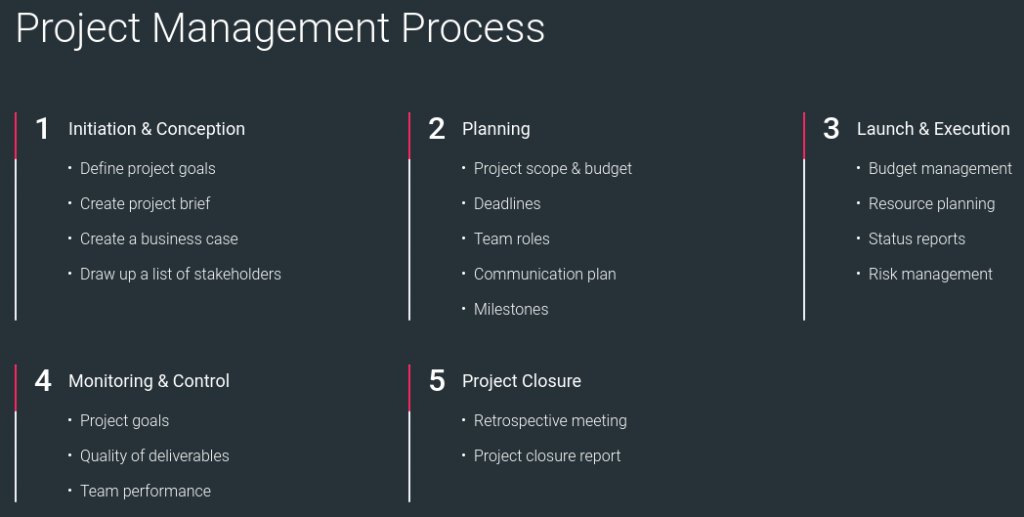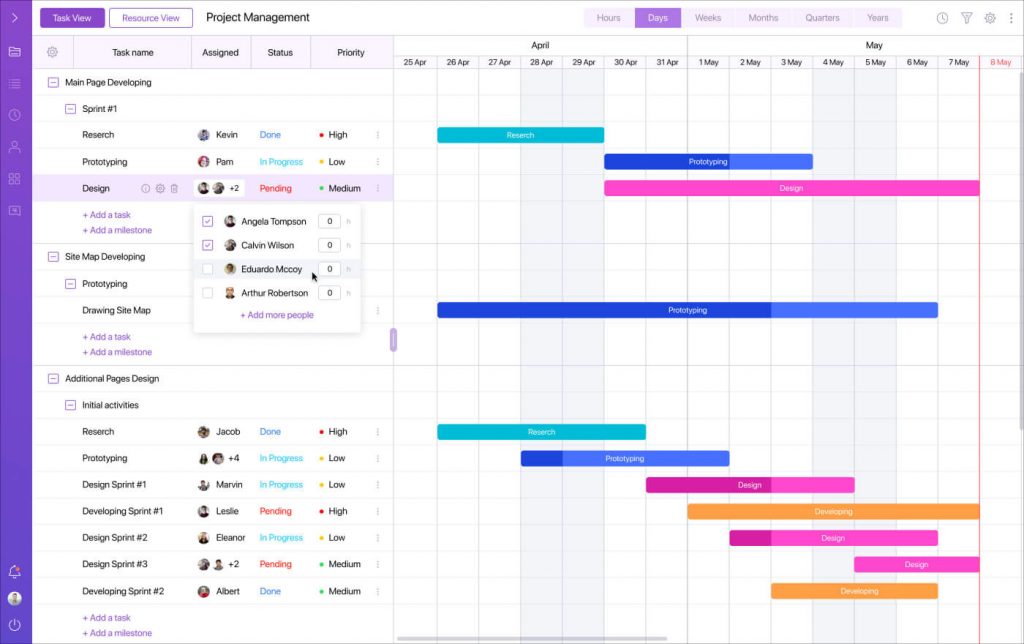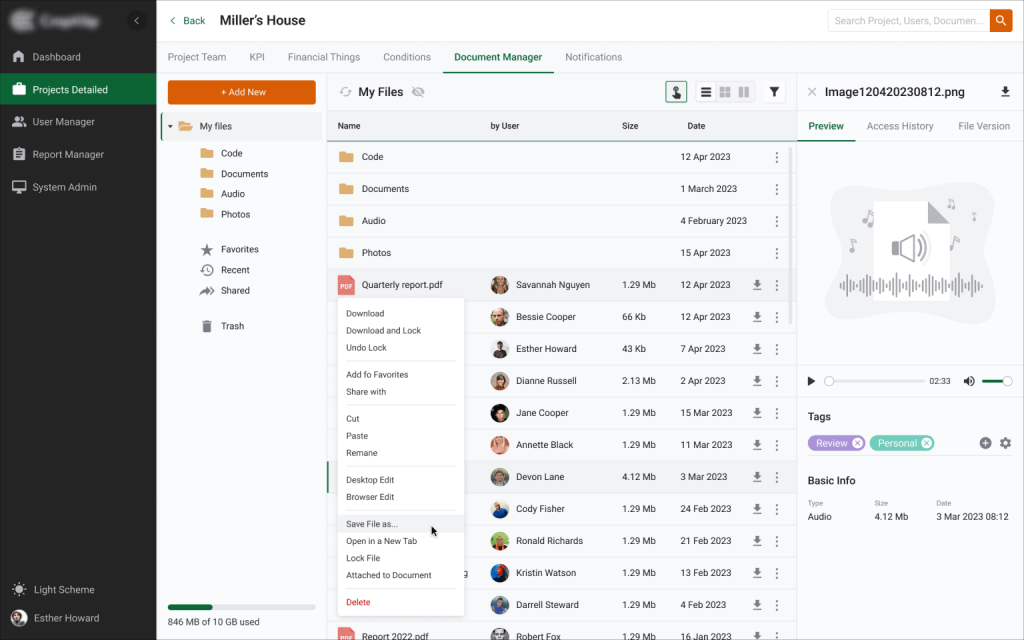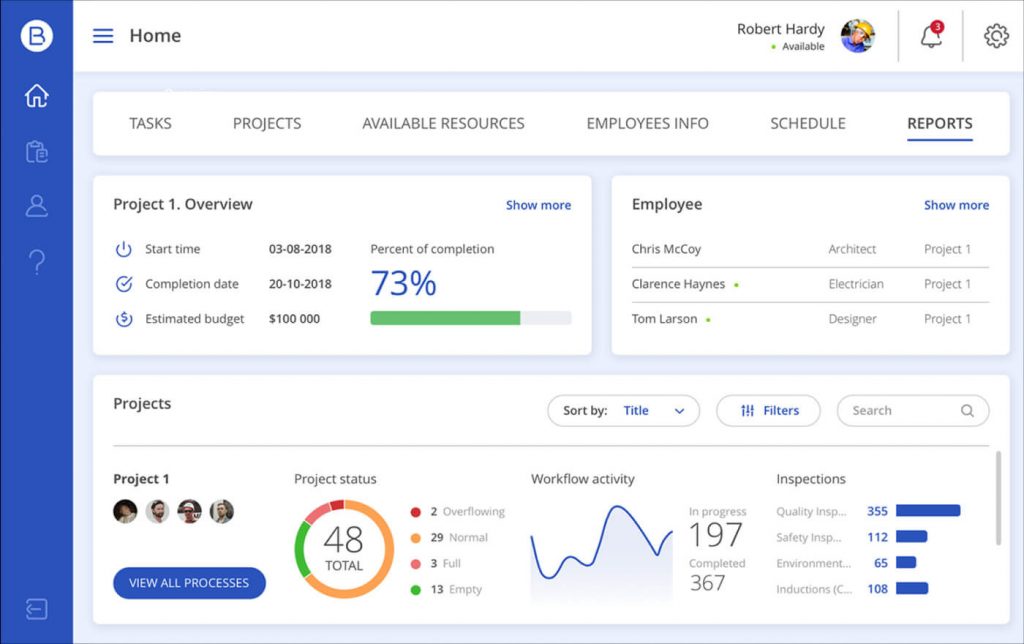Under the surface of every business success that we witness, well-planned and flawlessly executed projects represent the path an idea takes to its realization. The more innovative business ideas you wish to implement, the more complex and resource-heavy projects you’ll have to deal with. Under such conditions, a strong project management discipline has strategic importance. It can help align the company’s efforts toward reaching global strategic goals in time.
While every business has its project management specifics, some aspects remain the same from one company to another. Therefore, you can master your understanding of core activities involved in project management to minimize the need for improvisation with an unobvious outcome. Today, we’ll learn the main phases of the project management life cycle and consider some software solutions that may become somewhat helpful along the way.
Project Management Life Cycle in Five Steps
The ultimate goal of the five phases of the project management cycle that we’ll describe further is to help the team get the job done, keeping in mind the following main constraints: time, scope, quality, risks, and cost. Balancing between them is a vital task that requires due diligence from every company that wants to deliver a product successfully. To help businesses stay within the necessary boundaries and accept the best practices in the smoothest way possible, the Project Management Institute has developed the model of ideal project management life cycle.
The central concept behind the developed framework is to help project management teams meet their goals without wasting all resources along the way. Every project, according to this paradigm, goes through the following steps:
- Project initiation;
- Project planning;
- Project implementation;
- Project monitoring and control;
- Project closure.

Stage 1. Project Initiation
During this phase, the abstract idea (business problem or opportunity) starts transforming into a set of meaningful goals. A business case is formed to respond to these issues or potential prospects. It describes possible options allowing one to reach the desired goal.
The feasibility study helps determine whether the team can complete the project. Here, the project charter is created. This essential document contains such details as project constraints, budget, approximate schedule, and many others. What the project charter does not include are specific technical details of implementation. For example, if you want to build an electric vehicle and your goal is to knock Tesla out of the market, at this step, you don’t specify the capacity of its batteries. Instead, you focus on the time and budget required to build them.
Stakeholders are also identified during this phase of the project planning life cycle. Team members should clearly understand their roles and responsibilities. For this purpose, a stakeholder register can be created. It contains information such as roles, communication requirements, and the influence of each person forming a team working on the project.
Read Also Checklist of 8 Tips in Negotiating an Outsourcing Contract and How to Get Around Them Easily
The business case, feasibility study, and project charter contain enough information for key decision-makers to approve or reject the project. After the project is approved, the team can move to the planning stage.
Key activities:
- Make a project charter;
- Conduct a feasibility study;
- Create a business case;
- Identify the high-level scope of the project;
- Identify stakeholders;
Stage 2. Project Planning
Project planning takes a massive time in the overall management life cycle. The reason is that it’s a critical step to determining if all subsequent activities will be successfully completed. Here, the management team defines the scope and develops a project management plan. These documents contain the overall cost, quality metrics, deliverables, resources required to complete the project, and estimated timeline. For this purpose, there are dozens of solutions created by project management software developers to improve workforce planning. At the planning stage, for example, a system that uses the Gantt chart can become pretty handy:

Source: Project Management Application Based on the Gantt Chart
Due flexibility here is a must. Sometimes, because of miscommunication between the stakeholders or some other unforeseen circumstance, the team faces so-called “scope creep” situations. The term describes a project state where requirements tend to increase intensively. An effective change management strategy can help avoid massive problems in the latter stages of the project.
Sometimes, things go differently than the project management team has planned. To reach the goals against all odds, during this stage, the team can identify all threats that may appeal along the way and develop a strategy for overcoming them. Risk management, in this case, implies that not all dangers can be avoided. In some scenarios, all you can hope for is to reduce their impact on the project.
The project management team should develop a quality plan to ensure that the result is worth the effort and that the goals were successfully reached. It contains quality targets according to which the team can consider the project successfully finished. The acceptance plan includes the criteria for which the team perceives the final product corresponding to the customer’s business needs.
Key activities:
- Create project scope;
- Develop a project management plan;
- Estimate the budget;
- Set quality standards and create an acceptance plan;
- Identify the risks and create a strategy to overcome them;
- Assign team members to tasks;
- Prepare for change management;
- Create a communication plan.
Stage 3. Project Implementation
At last, the actual work on the project begins. The management team should monitor the process efficiently to determine the bottlenecks as quickly as possible. The actual results of work should be compared to the initial plan to determine the overall efficiency. Suppose the achievement of goals is called into question. In that case, the project management team can either try to return the project on track or choose a suitable variation to the initial plan and communicate changes to the stakeholders.
Read Also Release Plan in Agile: Strengthening Product Quality and Team Management with One Document
Since complex projects require the involvement of many specialists with different areas of expertise, maintaining efficient collaboration and communication is another crucial task. Luckily, plenty of stand-alone collaboration tools or complex project management systems provide access to such features. It may not only include chatting/calling apps but also file-sharing platforms allowing team members to leave comments and record notes using their voice:

Source: UI/UX Modernization for a Construction Management Web App
Key activities:
- Team leadership and guidance;
- Task briefing and execution
- Communications.
Stage 4. Project Monitoring and Controlling
The project management doesn’t have to wait until the execution phase finishes to launch this one. Monitoring the overall performance should run simultaneously with the project execution to ensure the objectives are met. Constant control over KPIs will help to indicate when specific team members deviate from the initial plan.

Source: Full-featured Project Management Solution for Construction Industry
Besides ensuring that deadlines are met, the project management team can ensure the budget is not exceeded. As new deliverables appear, the team can demonstrate them to the client to receive feedback and make necessary adjustments.
Key activities:
- Tracking the overall progress;
- Measuring budget;
- Informing stakeholders on required changes;
- Collecting and processing feedback;
- Quality management;
- Managing risks, acceptance, and changes.
Stage5. Project Closing
After the project is finished, all goals are reached, all quality requirements are met, and the final product can be delivered to the customer.
Now, it’s time for project closure. If you relied on IT augmentation services and a team of dedicated specialists was working on your project, that’s when you can close the contracts with them or make them a part of another project.
Also, at this step, you can summarize your experience. Reflection meetings help to ensure that the team members will increase their performance in future projects and won’t subject the project to the same risks again.
Key activities:
- Delivering the project to customers;
- Hosting post-implementation meetings and reviews;
- Archive project documentation;
- Releasing the team;
Conclusions
In project management, there’s no one-size-fits-all solution. With more or less success, you can predict what the specific stage of the project will look like based on the features of your business and your customers’ requirements. Therefore, following the schema described in this article will only partially cover the needs of your project management team.
Large numbers of variables and unpredictable aspects form multiple “gray zones” that can ruin seemingly solid foundations. In these circumstances, all you can do is improve your adaptability and flexibility by all means possible, including cutting-edge project management software solutions. If you need help figuring out where to start, contact us, and we’ll consult you about the recent developments in the field.